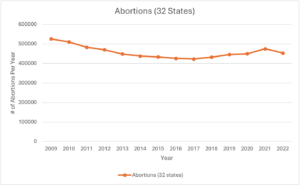U.S. Abortion Trends: 2021-2022

This is Issue 28 of the American Reports Series.
- This paper is an analysis of 2021 and 2022 abortion data published by state health departments. A discussion of recent estimates for 2023, showing net increases in total abortions, is also included.
- Of the 34 states that reported abortion data for both 2021 and 2022 as of April 2024, there was a 4% overall decrease in the number of abortions.
- In the 14 states that had a decrease in abortion, all had in effect either a life at conception law or a gestational limit on abortion protecting unborn children following the Supreme Court’s Dobbs decision, indicating that the pro-life state laws drove the country’s overall decrease by the end of 2022.
- In Oklahoma and Texas, for example, abortions dropped dramatically by 70% and 66%, respectively.
- Of the top 10 highest-volume abortion states based on Guttmacher data, California reports no abortion data, New Jersey stopped reporting data after 2020, Michigan recently passed a bill that eliminated the state’s abortion reporting requirements beginning in 2023, and New York has not released 2022 data as of April 2024.
- Fifteen states reported a decrease in drug-induced abortions in 2022, a majority of which had life at conception laws go into effect after the Dobbs decision.
2022 Trends
Total Abortions
As of April 9, 2024, there were 34 states that had released abortion statistics for both 2021 and 2022.[1] Twenty states reported an increase in abortions from 2021, while 14 reported that abortions declined. Overall, total abortions reported by these 34 states decreased by 4% from 2021. In all 14 states that saw decreases, the percentage decreases were more than 10%. In Oklahoma, abortions dropped by 70% and in Texas they dropped by 66%, while in Wisconsin abortions decreased by almost 50%. In the 20 states that saw increases, 11 reported increases in total abortions of 10% or more. Wyoming abortions increased by 424%, Kansas abortions by 57%, and Nevada abortions by 37%. In the 20 states that saw increases in total abortions from 2021 to 2022, 17 did not enact pro-life gestational limits after Dobbs v. Jackson Women’s Health was decided by the Supreme Court in June 2022. The outliers were Florida, Georgia, and South Carolina, which had 15 week (FL) and heartbeat laws (GA and SC) in effect for a portion of the latter half of 2022.
The states that had the largest absolute increases in total abortions were North Carolina (+7,583), Illinois (+4,660), and Kansas (+4,469). The states that had the largest absolute decreases were Texas (-34,346), Oklahoma (-5,127), and Ohio (-3,325).
These significant decreases in multiple states and the consequent overall decrease in total abortions in the United States from 2021 to 2022 were due in large part to multiple state laws that went into effect in June 2022 after Roe v. Wade was overturned by the Supreme Court in Dobbs. In all 14 states that saw a decrease, life at conception laws or other gestational limits on abortion were in effect for at least a portion of the time from June 2022 through the end of the year. These trends demonstrate the impact of the Dobbs decision on abortion incidence in 2022 and indicate that pro-life state laws drove the country’s overall decrease in total abortions.
Surveys of abortion facilities confirm these 2022 trends of significant total abortion decreases in pro-life states, increases in pro-abortion states, and a net decrease in total abortions in the United States because of the Dobbs decision. One report by the Society of Family Planning looking at data from July 2022 through March 2023 found that, during those nine months following Dobbs, abortions in pro-abortions states increased by approximately 56,000 but that the increase was offset by the steep declines in states that enacted pro-life protections. In pro-life states, abortions decreased by over 81,000 during the nine-month period, contributing to a net decrease across the country of 25,000 total abortions.[2] Lastly, another Society of Family Planning report looking at abortion data from April 2022 through December 2022 showed that there was a cumulative decrease of 32,260 abortions in the United States after Dobbs when compared to the pre-Dobbs period (April and May 2022).
Table 1 – Total Abortions Reported by States, 2021-2022 (34 States)
| State | 2021 | 2022 | % Change | Total Change |
| Alabama | 6,489 | 3,777 | -42% | -2,712 |
| Alaska | 1,226 | 1,246 | 2% | 20 |
| Arizona (Occurrence) | 13,998 | 11,530 | -18% | -2,468 |
| Arkansas | 3,133 | 1,621 | -48% | -1,512 |
| Colorado | 11,580 | 14,154 | 22% | 2,574 |
| Connecticut | 10,146 | 11,121 | 10% | 975 |
| Florida | 79,817 | 82,581 | 3% | 2,764 |
| Georgia (Residence) | 34,988 | 35,401 | 1% | 413 |
| Idaho | 1,553 | 1,027 | -34% | -526 |
| Illinois | 51,797 | 56,457 | 9% | 4,660 |
| Indiana | 8,414 | 9,529 | 13% | 1,115 |
| Iowa | 3,761 | 4,062 | 8% | 301 |
| Kansas | 7,849 | 12,318 | 57% | 4,469 |
| Kentucky | 4,441 | 2,550 | -43% | -1,891 |
| Louisiana | 7,444 | 4,570 | -39% | -2,874 |
| Maine | 1,915 | 2,225 | 16% | 310 |
| Massachusetts | 16,795 | 17,757 | 6% | 962 |
| Michigan | 30,074 | 30,120 | 0.2% | 46 |
| Minnesota | 10,136 | 12,175 | 20% | 2,039 |
| Mississippi | 3,817 | 2,286 | -40% | -1,531 |
| Nebraska | 2,360 | 2,507 | 6% | 147 |
| Nevada | 8,751 | 11,957 | 37% | 3,206 |
| North Carolina (Occurrence) | 32,454 | 40,037 | 23% | 7,583 |
| North Dakota | 1,153 | 754 | -35% | -399 |
| Ohio | 21,813 | 18,488 | -15% | -3,325 |
| Oklahoma | 7,287 | 2,160 | -70% | -5,127 |
| Oregon | 7,109 | 8,672 | 22% | 1,563 |
| Pennsylvania | 33,206 | 34,838 | 5% | 1,632 |
| South Carolina | 6,279 | 7,276 | 16% | 997 |
| South Dakota | 192 | 137 | -29% | -55 |
| Texas | 51,860 | 17,514 | -66% | -34,346 |
| West Virginia | 1,374 | 831 | -40% | -543 |
| Wisconsin (Occurrence) | 6,579 | 3,333 | -49% | -3,246 |
| Wyoming | 103 | 540 | 424% | 437 |
|
Total |
489898 | 465551 | -4.97% | -24,347 |
Graph 1 – U.S. Abortion Totals from States That Reported Data From 2009-2022[3]

Graph 1: Total abortions in the 32 states that reported statistics for 2009-2022. The numbers reflect occurrence, rather than residence, data for all states except Georgia. Arizona is not included in the graph because the state’s current reporting standards went into effect in 2011, and Wyoming is not included because the state’s data was incomplete before 2020.[4] Mississippi’s data is self-reported by the state for every year but 2020. Mississippi’s data for 2020 was taken from the CDC’s abortion surveillance report for 2020. Oklahoma’s 2021 total was taken from CDC’s abortion surveillance report for 2021 as the total released by the state, at the time, did not include late ITOP submissions from abortion facilities in the state.
This analysis of national abortion trends is known to be incomplete because many states underreport abortions or do not collect abortion data at all. Of the top 10 highest-volume abortion states according to the Guttmacher Institute’s 2020 Abortion Provider Census, California reports no abortion data, New Jersey stopped reporting data after 2020, Michigan recently passed a bill that eliminated the state’s abortion reporting requirements beginning in 2023, and New York has not released 2022 data as of April 2024.[5]
Abortion Drugs
Of the 34 states that have released 2022 abortion statistics, 32 reported drug-induced (also known as “chemical”) abortion data for 2021 and 2022.[6] Drug-induced abortions fell collectively in these 32 states by 4% from 2021 to 2022, representing 58% of these states’ total abortions in 2022, compared to 56% in 2021. In 25 states, drug-induced abortions composed half or more of all abortions in 2022.
Table 2 – Total, Drug-Induced, % of Total in Drug-Induced Abortions by State, 2021-2022 (32 States)
| State | Total (2021) | Drug-Induced (2021) | % of Total (2021) | Total (2022) | Drug-Induced (2022) | % of Total (2022) |
| Alabama | 6,489 | 3,653 | 56.3% | 3,777 | 2,186 | 57.9% |
| Alaska | 1,226 | 442 | 36.1% | 1,246 | 602 | 48.3% |
| Arizona (residents only) | 13,896 | 6,720 | 48.4% | 11,407 | 5,790 | 50.8% |
| Arkansas | 3,133 | 1,190 | 38.0% | 1,621 | 379 | 23.4% |
| Colorado | 11,580 | 7,430 | 64.2% | 14,154 | 8,832 | 62.4% |
| Connecticut | 10,146 | 6,552 | 64.6% | 11,121 | 7,701 | 69.2% |
| Florida | 79,817 | 46,433 | 58.2% | 82,581 | 45,488 | 55.1% |
| Idaho | 1,553 | 898 | 57.8% | 1,027 | 654 | 63.7% |
| Illinois | 51,797 | 27,344 | 52.8% | 56,457 | 32,018 | 56.7% |
| Indiana | 8,414 | 4,791 | 56.9% | 9,529 | 5,047 | 53.0% |
| Iowa | 3,761 | 2,992 | 79.6% | 4,062 | 2,985 | 73.5% |
| Kansas | 7,849 | 5,323 | 67.8% | 12,318 | 7,342 | 59.6% |
| Kentucky | 4,441 | 2,277 | 51.3% | 2,550 | 1,256 | 49.3% |
| Maine | 1,915 | 1,159 | 60.5% | 2,225 | 1,408 | 63.3% |
| Massachusetts | 16,795 | 8,311 | 49.5% | 17,757 | 9,276 | 52.2% |
| Michigan | 30,074 | 15,367 | 51.1% | 30,120 | 15,606 | 51.8% |
| Minnesota | 10,136 | 6,154 | 60.7% | 12,175 | 7,391 | 60.7% |
| Mississippi | 3,817 | 3,355 | 87.9% | 2,286 | 1,902 | 83.2% |
| Nebraska | 2,360 | 1,709 | 72.4% | 2,547 | 1,864 | 73.2% |
| Nevada | 8,751 | 4,426 | 50.6% | 11,957 | 5,974 | 50.0% |
| North Carolina (residents only) | 27,305 | 17,937 | 65.7% | 28,855 | 19,967 | 69.2% |
| North Dakota | 1,153 | 677 | 58.7% | 754 | 395 | 52.4% |
| Ohio | 21,813 | 10,240 | 46.9% | 18,488 | 9,225 | 49.9% |
| Oklahoma | 7,287 | 5,009 | 68.7% | 2,160 | 1,255 | 58.1% |
| Oregon | 7,109 | 4,240 | 59.6% | 8,672 | 5,472 | 63.1% |
| Pennsylvania | 33,206 | 18,370 | 55.3% | 34,838 | 19,011 | 54.6% |
| South Carolina | 6,279 | 4,623 | 73.6% | 7,276 | 5,217 | 71.7% |
| South Dakota | 192 | 71 | 37.0% | 137 | 50 | 36.5% |
| Texas | 51,860 | 26,864 | 51.8% | 17,514 | 11,912 | 68.0% |
| West Virginia | 1,374 | 757 | 55.1% | 831 | 403 | 48.5% |
| Wisconsin (residents only) | 6,472 | 2,486 | 38.4% | 3,279 | 1,171 | 35.7% |
| Wyoming | 103 | 103 | 100.0% | 540 | 540 | 100.0% |
| Total | 442,108 | 247,904 | 56.1% | 414,261 | 238319 | 57.7% |
Seventeen states reported that drug-induced abortions increased from 2021. Wyoming had the largest percentage increase (424%), while Illinois had the largest absolute increase (+4,674 drug-induced abortions). In 2022, 13 states reported increases in drug-induced abortions of more than 10%, with four of those states reporting an increase of more than 30% from 2021.
Fifteen states reported a decrease in drug-induced abortions in 2022. Of these 15 states, total abortions decreased in all but two (Iowa and Florida). All but two (Ohio and Arizona) of those 13 states had life at conception laws go into effect after the Dobbs decision.[7] Oklahoma had the largest percentage decrease in drug-induced abortions (74.9%), and Texas had the largest absolute decrease (-14,952 drug-induced abortions).
The general trend towards increasing use of abortion drugs is likely to continue, as 2022 was the second full year since the Food and Drug Administration (FDA) announced its decision to make permanent its removal of the requirement for prescribers to dispense mifepristone in person. This decision allowed the drug to be dispensed by mail and in pharmacies. As of this writing, at least three states (Idaho, Kansas, and Missouri) are seeking to challenge the FDA’s regulation of abortion drugs in the wake of the Supreme Court’s recent decision in FDA v. Alliance for Hippocratic Medicine, which allows FDA’s lax regulations to continue.
Updates to Gestational Laws
In CLI’s 2023 paper detailing abortion trends in the United States from 2021 to 2022, the gestational laws of every state were described given the massive change in states’ gestational laws following the Dobbs decision. This section is focused on providing updates to states’ laws that have changed since that paper was published in July 2023. Those updates are as follows.
- Arizona: On April 9, 2024, the Arizona Supreme Court ruled that the state’s life at conception law, originally in effect prior to Roe, could go into effect (Planned Parenthood Arizona v. Mayes 2024). This law prohibits abortion, except when the mother’s life is endangered by the continuation of her pregnancy.[8] The law went into effect for a brief period of time in September through October 2022, but when the law was challenged in court, Arizona Attorney General Mark Brnovich at the time agreed not to enforce the law until 2023. However, he was defeated in Arizona’s 2022 November election and the new Attorney General, Kris Mayes, despite being a plaintiff in the case described above (by default of her office) is pro-abortion. In December 2022, an appellate panel of judges ruled that the law could not be enforced. However, this decision was vacated by the April 9 ruling. The state’s pre-Roe law was in effect for a short while after the April 9 decision until Attorney General Mayes obtained a 3-month delay from the Arizona Supreme Court (on May 13, 2024) meaning that the law would not be enforced until September 2024. However, on May 2, Governor Hobbs signed HB 2677 which repeals the law. This repeal went into effect July 31, 2024. Abortion is now limited to 15 weeks gestation in Arizona.
- Florida: On April 1, 2024, Florida’s Supreme Court determined in Planned Parenthood of Southwest and Central Florida, et al. v. State of Florida that the state’s constitution does not include a right to an abortion. Consequently, Florida’s 15-week law was upheld and the state’s six-week law (SB 300), signed into law in April 2023, went into effect on May 1, 2024.[9] SB 300 limits abortion after six weeks of gestation.[10] Exceptions to this law include abortions in the case of fetal anomalies. This exception only applies to pregnancies that have not progressed to the third trimester. The law also contains exceptions for abortions in the cases of threats to the mother’s life or a major bodily function, rape, incest, and sex trafficking. The latter three exceptions apply to pregnancies that have not progressed past 15 weeks of gestation.
- Indiana: On August 21, 2023, Indiana’s life at conception law (SB 1 2022 Special Session), passed in September 2022, went into effect as a result of an Indiana Supreme Court ruling. The Indiana Supreme Court ruled in the case Members of the Medical Licensing Board of Indiana v. Planned Parenthood Great Northwest, Hawai’i, Alaska, Indiana, Kentucky, Inc., et al. (2023) that the law was constitutional after it had been blocked a week after its passage in September 2022. The law prohibits abortion except to save the life of the mother or prevent major physical impairment, or in cases of rape, incest, and fetal anomalies. The rape and incest exceptions apply to pregnancies before 10 weeks of gestation and “lethal” fetal anomaly exceptions only apply to pregnancies before 20 weeks of gestation.[11]
- Iowa: On June 28, 2024, the Iowa Supreme Court ruled that the state’s heartbeat law was constitutional and could go into effect in 21 days, reversing a previous decision by a lower court. The heartbeat law went into effect on July 29, 2024.
- Maine: In July 2023, Maine Governor Janet Mills signed HP 1044 into law. This law made the exceptions to Maine’s viability law even more broad than the previous version. Before the passage of this law, Maine had no de facto limits on post-viability abortions as the health exception was undefined. However, the passage of HP 1044 removed the health exception altogether and replaced it with an even weaker condition for when abortion can be performed post-viability: “… only when it is necessary in the professional judgement of a physician …”[12]
- Ohio: In November 2023, a majority of Ohioans voted ‘yes’ on Issue 1, a ballot initiative that proposed adding a constitutional right to abortion to the Ohio Constitution. The passage of this ballot initiative invalidated the state’s heartbeat law (which had previously been enjoined). The state’s 22 (LMP) week law remains in effect.
- South Carolina: After South Carolina’s heartbeat law was passed in early May 2023, it was blocked one day after going into effect in late May. However, the injunction on the law was lifted by the South Carolina Supreme Court on August 23, 2023, and the law has remained in effect since then. The law prohibits abortion after an unborn baby’s heartbeat has been detected (typically around 6 weeks of gestation), except when:
- The pregnancy threatens the mother’s life or physical health.
- The woman is a victim of rape and/or incest.[13]
- The unborn child has been determined to have a “fatal fetal anomaly.”
- Wisconsin: In July 2023, a Wisconsin county judge ruled that Wisconsin’s pre-Roe life at conception law doesn’t prohibit elective abortions, but rather only instances where someone attacks a woman in an attempt to kill her unborn child. The ruling did not end the lawsuit that the state had brought against the law. However, Planned Parenthood locations in Milwaukee and Madison started providing abortions through 21 weeks in September 2023 and have continued to do so ever since. In December 2023, the same county judge reaffirmed her July 2023 decision.
Predictions for 2023 Data and Beyond
As of August 2024, abortion data from 2023 has been released by 12 states: Alaska, Arkansas, Colorado, Florida, Indiana, Michigan, Nebraska, Oklahoma, South Carolina, South Dakota, West Virginia, and Wyoming. It is likely that while reports will show decreases in states with pro-life laws, there will also be an overall net increase of total abortions reported in the United States in 2023 due to massive increases in pro-abortion states like Illinois, Kansas, and New Mexico. The Guttmacher Institute recently released a report estimating that 1,037,000 abortions occurred in the formal health care system in 2023.[14] This number cannot be compared to the total number of abortions reported by the states in 2022, due to a lack of reporting by high-volume abortion states, but Guttmacher’s report noted that the 2023 abortion total was the highest United States total in a decade. A Society of Family Planning analysis that compared monthly abortion totals two months before the Dobbs decision to monthly totals from July 2022 through June 2023 showed that, while abortion totals decreased throughout 2022, volumes increased in 2023 and resulted in a cumulative total of 2,200 more abortions during this time period. In August 2024, Society of Family Planning released a report showing estimated monthly abortions totaling 1,053,690 abortions in 2023, similar to the Guttmacher estimate.
The significant increase in abortions in pro-abortion states was driven by both abortions on state residents and women traveling from other states. The Guttmacher Institute report discussed above noted that pro-abortion states like Illinois, which borders pro-life states with life at conception laws, saw large increases from 2020 to 2023 in the percentage of out-of-state patients who obtained abortions.[15] However, the report also noted that because of permissive state abortion policies, more in-state residents obtained abortions as well.
Lastly, another factor in the overall increase in total abortions in 2023 was the increase in drug-induced abortions. The Guttmacher Institute reported that the use of abortion drugs rose from 53% of all abortions in 2020 to 63% in 2023. Guttmacher estimates that over 642,000 abortions that took place in 2023 were done via abortion drugs. One contributing factor was an increase in abortions by virtual-only clinics.
Although Guttmacher’s abortion totals do not include abortions performed under shield laws, other data indicates shield laws are contributing to the overall increase in drug-induced abortions.[16] The Society of Family Planning released estimates according to which approximately 41,010 mail-order drug-induced abortions were performed under shield laws in 2023. All told, “telehealth” abortions, or abortion drugs obtained online,[17] continued to climb throughout 2023, making up 20% of all abortions in early 2024.
Even though preliminary data suggests that abortions increased in the United States in 2023, abortion totals will remain low in the states that continue to enforce and enact strong pro-life gestational limits.
Mia Steupert, M.A. is a research associate at the Charlotte Lozier Institute.
Tessa Cox is senior research associate at the Charlotte Lozier Institute.
[1] Alabama, Alaska, Arizona, Arkansas, Colorado, Connecticut, Florida, Georgia, Idaho, Illinois, Indiana, Iowa, Kansas, Kentucky, Louisiana, Maine, Massachusetts, Michigan, Minnesota, Mississippi, Nebraska, Nevada, North Carolina, North Dakota, Ohio, Oklahoma, Oregon, Pennsylvania, South Carolina, South Dakota, Texas, West Virginia, Wisconsin, and Wyoming. The remaining 17 states, the District of Columbia, and New York City did not report 2021 and 2022 abortion data by April 9, or do not collect or report abortion data (California, Maryland, New Hampshire, and New Jersey). For an analysis of state abortion reporting standards, please see: https://lozierinstitute.org/the-state-of-abortion-reporting-in-2024-america-still-striving-toward-a-better-national-standard/.
[2] While the referred-to report looks at a slightly different time period than the state data discussed in this paper, it demonstrates the same general abortion trends following the Dobbs decision through the end of 2022.
[3] Alabama, Alaska, Arkansas, Colorado, Connecticut, Florida, Georgia, Idaho, Illinois Indiana, Iowa, Kansas, Kentucky, Louisiana, Maine, Massachusetts, Michigan, Minnesota, Mississippi, Nebraska, Nevada, North Carolina, North Dakota, Ohio, Oklahoma, Oregon, Pennsylvania, South Carolina, South Dakota, Texas, West Virginia, and Wisconsin.
[4] Wyoming reported abortion data for only part of 2019 and did not report data at all before then.
[5] These 10 states include (and the corresponding number of abortions that occurred in each state in 2020 per Guttmacher Institute): California (154,060), New York (110,360), Florida (77,400), Texas (58,020), Illinois (52,780), New Jersey (48,830), Georgia (41,620), Pennsylvania (32,260), North Carolina (31,850), and Michigan (31,500).
[6] Georgia’s online vital statistics portal does not specify the types of abortion procedures used. Louisiana does not report drug-induced abortions as a unique category.
[7] Ohio had a heartbeat law go into effect for a part of the latter half of 2022 when Roe was overturned, and Arizona had a life at conception law in effect for part of the latter half of the year, and then a 15-week law went into effect after Arizona’s life at conception law was blocked.
[8] Ariz. Rev. Stat. Ann. §13-3603.
[9] As CLI noted in its 2023 paper on abortion trends, the state’s ability to enforce SB 300 was contingent on the Florida Supreme Court’s upholding the state’s 15-week law that had been in effect since July 2022 in the case of Planned Parenthood v. Florida.
[10] This legislation will be able to be found in Florida Statute Code 390.0111 §4.
[11] Ind. Code 16-34-2-1 to 16-34-2-5.
[12] 22 MRSA §1598.
[13] South Carolina’s 2023 heartbeat law’s rape and incest exceptions have a gestational limit of 12 weeks.
[14] Guttmacher’s 2023 totals as reported by the Monthly Abortion Provision Study are not reported by the states, but rather estimates by Guttmacher based on rolling surveys of abortion centers in different states combined with statistical modeling to impute missing data.
[15] For example, out of state residents went from composing 21% of Illinois abortions in 2020 to 41% in 2023, 38% of New Mexico abortions in 2020 to 69% in 2023, and 52% of Kansas abortions in 2020 to 71% in 2023.
[16] Shield laws allow abortionists to mail abortion drugs to women (even women in pro-life states that prohibit most abortions or enforce gestational limits). These laws prohibit, through statutory and/or constitutional protections, those abortionists from being held accountable by authorities in pro-life states.
[17] “Telehealth” in this context includes abortions performed via virtual-only clinics, brick and mortar centers that offer telehealth services, and abortion drugs shipped via the mail to women in pro-life states (after June 2023) under shield laws.



























